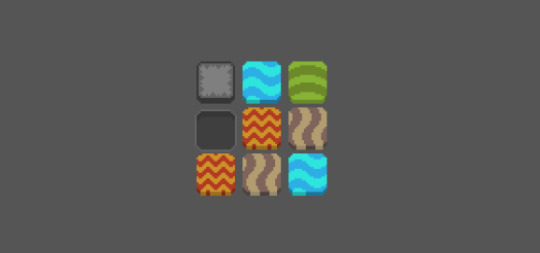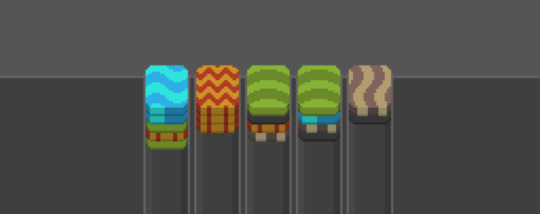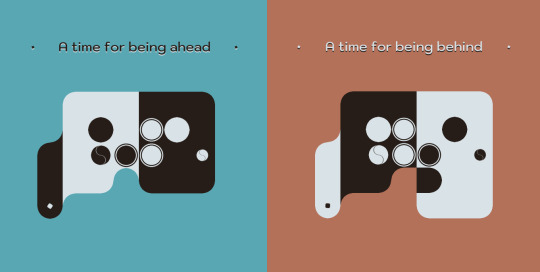Text
Layers
Wow, what a Ludum Dare last weekend. 72 hours to make a game based on a theme, this time being: “Deeper and deeper”. Normally it takes me a huge chunk of the time trying to think of an idea I want to explore, this time was no different, but actually the time where less I knew what I was doing for the longest time. This is a journey in detail of how I designed the game:
------------------------------------------------------------Brainstorm
Ludum Dare started 3 AM here, so I decided to go to sleep prior to the announcement of the theme, and handle it next morning. I spent most saturday just blocked without any interesting idea to pursue, however, there where two concepts that kept coming back to me:
Digging game, but with water, which spreads when there is space to the right, left or bottom. This would affect the character, making him float, having a sort of “Snake and ladders” situation.
Fossils card game. Having a board with dinosaurs, different cards for different type of soils, in each turn players would place those cards over the board, creating piles that players would have to dig in a second phase of the game.
Whenever I’m looking for jam ideas, there are two big questions to ask “Do I want to make the game?”“Can I do the game in that time?”, very early on I need to know that there will be some art-light way of presenting the game to the player, since I’m not a good artist, and that the programming will be bounded enough.

------------------------------------------------------------Blind work
At night, I was dry. No clear goal, no line of mechanics, no concept of game, no hint of the art and no focused path. I didn’t even open the game engine yet to prototype anything.
“At this point I should be making something, anything”
Opened Game Maker 2, and, inspired by the two previous ideas, I decided to start with the art, trying to make a sprite that could work both as a tile and as a card. Of course, I started with water.
Somehow, I got into the flow of drawing tiles, and made some more. I got a nice looking physical tile look that draw my attention, and worked on a free space spot where these tiles would fit.
End of day 1.

------------------------------------------------------------Rules
The physical look of the tiles made it weird to make a side view digging game, but I still wanted to explore this idea. I started creating a player character (a cursor), with a movement affected by the tiles the character was in.The first rules I made where:
Empty: player falls south / gravity.
Water: player floats north / buoyancy.
Fire: ice movement (ironic)
This batch of 3 simple rules was extremely corner casy, like an infinite loop between water and empty, or ending on fire at the edges of the screen. I tried a couple of variations to make it feel right, but it wasn’t making any sense.
However, I liked the idea of moving around the tiles, so worked from there:
Tiles affecting adjacent tiles: The player movement could be normal, but have some stats (life, oxygen, speed) affected by the tile they were in, and after X number of turns, tiles would affect its surrounding. Again, some unintuitive cases made the system unpleasant (fire next to water, who wins?)
Character actually acting as a cursor to select things: I really disliked this approach, a mouse input system would make much more sense. It also felt closer to a match 3 game, that I wanted to avoid, so players wouldn’t be influenced by an existing genre.
Character movement affecting tiles: Ah! This was interesting! It was easy to define rules, the player had much more control over the board and the number of things that happened per turn were limited to 1, making much readable. Got some rules in that made the system playful and unbalanced before letting it rest.

------------------------------------------------------------Sound
Break from design to make some sounds to have a better idea of how the game felt, good sounds can really help understanding a game and allow for more minimalist animations.
I looked for some sounds in freesound.org, and treated them with audacity, combining, removing noise, cutting, adding small effects...
After that I opened Ableton to start composing a main theme for the game. I usually start finding a pair chords + sound preset to get going, after that, a simple melody and some beats. I then copy and paste the number of bars a couple of times, making a couple of variations (no drums here, melody ends differently...), find a spot for a drop down, adding a couple of instruments and followed to reintegrating all the elements in a more uniform composition.
This is the first time that I made the audio in the second day instead of the last, and I really appreciated being able to listen to everything for a longer period of time, to find the weakest spots and change them if possible/necessary (I unfortunately didn’t have the time to polish the song, sad emoji).
------------------------------------------------------------Objective
I jumped to the design to figure out what the game was about before going to sleep. The temporary set of rules I had was clear about something, there were elements that were predominant, and had more chances to end up overpopulating the screen; I needed a way to get rid of tiles.
At this point, I was pretty convinced that I needed to make the game about sedimentation and fossils being preserved, digging was at this point pretty unrelated, and if not, the game would be completely out of the jam’s theme.
To better represent the sedimentation I needed to stack the tiles, and that implied that the information was much less readable once they were stacked. I needed a way to let the player understand the quality of their performance by solely looking at the grid.
I created an automatic system that after X moves a new row would appear on top, and the bottom discarded to the sedimentation pile, that would be the “final score”. Since information needed to be on the grid, every tile should have a clear value to the player, being the lazyest option: points. Another score attack game.
I don’t think points are the funnest stimulous, but they get the work done in a game jam, and I find very fun designing fair system points; there is something pleasant about finding numbers pattern matching what you think it’s fun about the game.
End of day 2.

------------------------------------------------------------Play
After spending the morning making the gameplay loop to work, it was time to play with a more critic mindset. Some weak points I noticed:
The automatic counter condition (X moves) felt claustrophobic, every move mattered, so it wasn’t only deciding how to alter the elements but finding the optimal path. Also, the system creates kind of a dynamic laberinth, where the direction you enter a tile matters, meaning that detouring is a necessary technique for getting the best boards; hence penalizing movements was contradictory. Focusing only on turns where there was some change in the grid seemed to be a much more interesting approach (This was much clearer because I already added the SFX for the “special” moves while there was nothing for the “normal” ones.)
Rock power up (Pushing a row or column) was very strong, if you managed to have two, it was most of the time the best move to make, allowing to change the positions of 5 tiles in a single turn. I needed to limit the number of uses, specially given that I wanted this to be the tile with more value, creating a tension between the powerup and the points it would give.
Air powerup (swapping with any tile) was really weak in comparison to stone, and I wanted both to be seen as “items”, limiting its uses too. I decided to make air actions free, but I regretted it later.
Fire was rarely useful, and only something you wanted to extinguish as soon as possible. Adding a new positive interaction could create more interesting decisions of when to extinguish it. I looked at the possible interactions of the fire with existing tiles, and created a new tile, sand, made by drying mud. I added a couple more interactions to make it part of the system (mud + air: sand, water + sand: mud)
Polishing the values of the tiles after seeing what a random run’s score was, the ideal to me is that the score is near zero, so I decreased the value of all tiles by 1. I also reordered the values so the “heaviest” tiles were the best, trying to match the theme, as well as making the most valuable tiles not appear directly on the grid (a new line is made first by fire, water, grass, mud and one empty space, and then change one random place to another empty space).
Intuitively I chose a maximum of 8 rows, so runs were short, but long enough that empty spaces could ruin the score, making the management of those key for the best scores.

------------------------------------------------------------Tutorial
This is usually my nemesis. I tend to underexplain the mechanics and system of my games and players normally struggle to understand what is going on; I’m in a never ending journey to a middle ground between giving enough information to get started but never holding the hand of the player.
In this case, despite seeing the special moves as simple individually, there were a lot of them, so teaching all of them was not an option: it was too much information at once. However I should explain the difference between a normal move and a special move.
First time doing an interactive tutorial, and I think the result is good, there is a small of initial information, given step by step, and that instead of giving away everything, stops by encouraging players to explore and explicitely acknowledging the lack of explanation. It works much better, although it isn’t everybody’s cup.
Probably the biggest flaw is not pointing towards the UI elements (tile values and highscore list), which was the part of the game the least understood (I misjudged the clarity of those). I also regret forcing the tutorial to stop, instead of allowing to experiment freely until the player pressed or hold a key to start the first run.

------------------------------------------------------------Polish
Nothing interesting here, except that for the sake of consistency, I made the air power up cost a special move very late, without balancing further, making it a tile that felt more as a punishment than a tool. I will probably add a couple of rules to it after the jam ends to make it more valuable. The rest was adding visual polish, mainly to the score system which was the last thing I added.
End of day 3

------------------------------------------------------------End
This is layers: https://le-slo.itch.io/layers
0 notes
Text
Inner Tao - Pre-Post-Mortem
Last time I wanted to tackle how I felt about the puzzles and mechanics of Inner Tao, after not having worked on it for quite a long time (specially in terms of level design, almost a year and a half).
It was strange. As weird as seeing code from a year ago, meeting someone else’s puppy after a couple of months, or going back to the neighborhood you grew up in. It was nostalgic and clunky, a reimagined forgotten memory.
The mechanics are minimal (so much that we could talk about a vanilla & chocolate Sokoban), with more depth that one would suppose. This is apparently good.
The levels are awkward, with pretty vague aha moments. Deductions are foggy and assumptions volatile. This is apparently bad, however, I don’t think the problem is in the levels per se, but in the way the mechanics take over the possibility space.
This is something I missed early in the development of Inner Tao, playtesting more and probably listening more carefully should have arisen some of these less literal problems. However, as this was sort of a “practice” project, a declaration of intents to myself, I followed a contradictory path I was too deep into to walk back.

Despite not seeing them as my best puzzles so far, I was decided to pursue the beauty I could see in Inner Tao, I just needed to work on it for a little more. I also owed it to both my past and future selves.
I leaned into the theme as the core pillar of the game, and reworked at least half of the puzzles to make the pairs of puzzles shine as a pair and not as individual puzzles. The shape, the initial and end positions or the gameplay narrative of the levels are linked between all these pairs (as well as the titles, inspired on the Tao Te Ching), being best the more literal this ressemblance is. This end up with a more unexpected difficulty curve or some less restricted levels, alienating the puzzleness of the game in order to bring a more meditative experience (there is a type of meditation that consists in walking in circles with an empty mind).
These are design choices that in my opinion made Inner Tao both better and worse, a game full of contradictions. These were choices that I enjoyed encountering very much, had a great time dealing with them, appreciated the opportunity to take the wrong answer and that I cannot but wish them good nights, since it’s time to look for new choices to make.
Celebratory ending.
0 notes
Text
Inner Tao - A meditative and long journey
12th April - Release of Inner Tao, my first commercial release.
Uff, sincerely, it was about time.
I started working on it 2 years ago,although it’s been quite a “busy “period of time and didn’t spend all that time on the game. *Checks progress tweets*. Ok, Wow! I only worked actively on this game for a total of 7-8 months. More detail in this inhomogenous timeline:
2 years and a half of being an active hobbyist gamedev.Made a (first) puzzlescript game. “Yin Yang”: the game was born.
Decided to explore further on Game Maker Studio 2. Worked on it for 4 months.
Break to work on lightning fast puzzlescript games (10 games in a month) and the GMTK jam.
In August I tweeted “Brainstorm and shipwreck”. Burnout was calling at the door (I won’t go into details right now, but remember, burnout is a thing, take care of yourself, listen to both your body and mind, mental health is volatile in many, at first, inimaginable ways)
6 months of slow recovery.
Worked again on it for a couple of months, did a trailer and announced the game.
Discovered the terrible wall of fiscal obligations for releasing a game that I couldn’t afford at the moment.
During that time I started working with Gwen Frey in Lab Rat, which was really exciting, releasing the pressure of having Inner Tao unreleased.
2021 Started working full time in Lab Rat.On March I decided to finally finish Inner Tao.
Inner Tao was during this last month a ghost with unfinished business [and bureaucracy], a hopeless soul subtlely haunting, a conscience of a previous life, a broken record of the past. But I can finally say, share, write and type “I’m free”.
Is not that I want to be melodramatic or cynical, this process has been extremely valuable and I’ll cherish it bittersweetly, but there were so many different layers I had to deal with that felt dangerously anachronic, that I only can reassure me for climbing to the top of this tiny first mountain.
(Oh, my ability to summarize is negligent. I could (I’m going to) end the post here although I haven’t even started to talk about what I initially wanted to. I think short posts are easier to read (yeeees, and write, maybe I’m just being selfish) and this article kinda feels like it’s ending?)
0 notes
Text
What
Words, process, intention, attempt, sharing, opinion, evolution?
When I write, I don’t know what I’m writing.
When I make, I don’t know what I’m making.
And now, I’m doing both. The 1st of January of 2021 it was my first day as a full-time game developer, the first of many first days. This wouldn’t have been possible without Carina initiatives and Gwen Frey. Thank you.
I love notebooks. There are several in my table, to disguise me as organized “the blue one is for game design and the small to write down e-mails or phone numbers”. No, they are all the same: buckets of ideas and scribbles and poetry and boredom, everything is allowed in those pages except for ripping them off; I like my process raw.
That’s what I came to do here, a paper mirror of my thoughts, focused on the game developer part of my life, *how I do* when I do.
1 note
·
View note